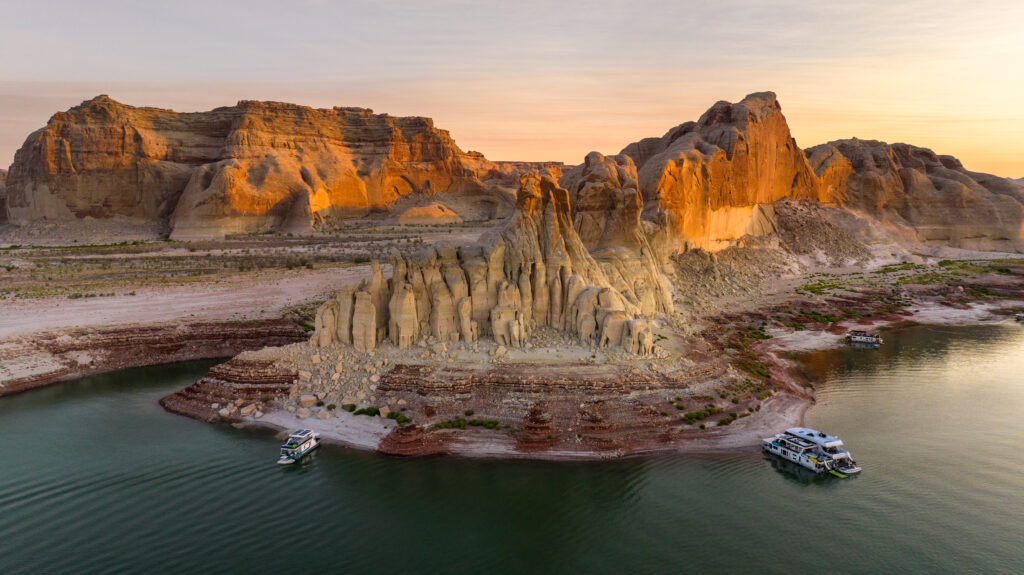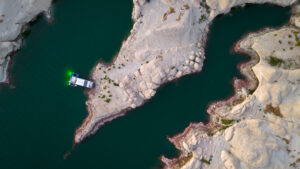How to Install Underwater LED Boat Lights – Part 3: How to Use 3M Marine Adhesive Sealant
How to Use 3M Marine Adhesive Sealant In Part 3 we’ll go through how to use 3M Marine Grade Adhesive to create a water tight

Lake Powell—the second largest manmade lake in existence—spans 185.5 miles from Southern Utah into Northern Arizona. Its formation began in the 1960s through the creation of the Glen Canyon Dam which forces water from the Colorado River into Lake Powell. In 1980, the lake hit full capacity, but that didn’t last long.
When the year 2000 came, a megadrought, the worst in 1200 years, began. Not only are we still in this drought, but it isn’t projected to get any better for at least another decade. And our overuse hasn’t helped the situation. As we accelerate the lowering levels of bodies like the Great Salt Lake, we make heavy snowfall less likely. This feeds into a vicious cycle of more and more depletion without ample replenishment. All of this in mind, Lake Powell’s situation is pretty grim. As of 2022, the water level had dropped to 3,519.01 feet and was expected to hit dead pool levels by about 2027.
Since its formation, Lake Powell has become a haven for water-loving Utahans and Arizonans. Hundreds of companies have built their brands around Lake Powell recreation and its massive industry draws almost three million visitors a year. Many families go to the lake annually and see the lake almost as a close family friend. People take their boats out to Lake Powell for wake surfing, wakeboarding, water skiing, knee boarding, tubing, and just spending time with their families. But lowering water levels threaten many of these activities. Lake Powell activists fight for measures that will conserve water, allowing for the Powell water level to reach an optimal 3,588 feet—which would maximize the lake’s recreational potential.
But beyond the recreational industry of Powell, the lake serves functions that can mean life or death. Lake Powell provides water to the lower basin states (Arizona, California, and Nevada) and keeps the Glen Canyon Dam alive. Earlier, I used the term dead pool. It refers to a body of water with levels that aren’t high enough to produce hydroelectricity. If that were to happen, Glen Canyon Dam, which produces energy for seven western states, would cease functioning.
Based on the context above, you’d think everyone would be gung-ho about saving Lake Powell, right? Wrong. There is so much more to this than first meets the eye. It was controversial at its genesis and has only become more controversial.
It all starts with the location itself. Powell’s waters bury a treasure trove of prehistoric Native American ruins and artifacts. In the earlier 1900s (before the Glen Canyon Dam was created), many wished to protect this area as a national park. But their efforts clearly failed. Some now argue that since Lake Powell has been around for a while, the historical sites are likely too eroded to be of much value anymore, but many hold out hope that if the water were to be removed that the sites would still be mostly intact. Herein lies a portion of the “Drain Lake Powell” crowd.
 However, the historical significance is not the primary argument for draining the lake. There’s another problem with the placement of Lake Powell—it’s smack dab in the middle of a desert. Because it’s a lake in a place where a lake doesn’t belong, Lake Powell loses approximately 860,000 AF of water to evaporation and bank absorption every year. That’s six percent of the Colorado River water going to waste. From this angle, many argue that it’d be more efficient to allow all the water from the river to fill Lake Mead.
However, the historical significance is not the primary argument for draining the lake. There’s another problem with the placement of Lake Powell—it’s smack dab in the middle of a desert. Because it’s a lake in a place where a lake doesn’t belong, Lake Powell loses approximately 860,000 AF of water to evaporation and bank absorption every year. That’s six percent of the Colorado River water going to waste. From this angle, many argue that it’d be more efficient to allow all the water from the river to fill Lake Mead.
This begs the question: if we put recreational purposes aside, is there good reason not to drain Lake Powell? Yes. While there are considerable arguments for draining it, there are significant arguments against it. If we drain Lake Powell, we’ll have to rewrite the western water allotment agreements, leading to lengthy negotiations and a lot of interstate tension. If we drain Lake Powell, Glen Canyon Dam will stop producing hydroelectric power. We’d likely have to replace the output with nonrenewable energy, heightening other issues such as pollution. And if we drain Lake Powell, a half a billion-dollar industry will shut down. Not to mention that we would lose all local businesses unrelated to but reliant on lake goers as well as all economic traffic Powell inspires nationally.
We are left with an annoying conclusion: it’s a huge, complicated mess. But there’s good news. For now, Lake Powell is still alive and we’re not to the point of no return quite yet.
If you are a Utahan, you may have noticed the crazy amount of snowfall we got over the winter. The snowmelt runoff led to Lake Powell’s water level peaking at 3584.68 on July 8th, where it was at 3539.44 on the same day last year. We haven’t gotten that kind of snow in almost fifty years!
But, while the heavy winter bought us some time, we’re still not out of the red. The megadrought is still at large and Lake Powell’s head is still on the chopping block. We need to be careful and take special measures to take advantage of the higher water level. Powell would need about a decade worth of winters as wet as our last one to fully regain its optimal water levels, and we all know that isn’t happening.
Since that peak in July, the water level began to decrease in small increments, but it has now mostly plateaued. While a large part of that decrease was due to outflows mandated by the Colorado River 2007 Interim Guidelines, some of it just boils down to the time of year. The late summer months are hot and the last of the snowpack eventually melts away.
We’ve had a good year, but having enough water out here is an uphill battle. Admittedly, we can’t do much on an individual level about most of the water consumption in the West, but we can yield every bit of power we do have. So, while we should use our water responsibly as individuals, making sure to support legislation that regulates water usage in an ethical way is where we can make a larger impact. Then, hopefully, we can continue to enjoy the beautiful Lake Powell for years to come.
To keep updated on what’s happening with Lake Powell and get involved in helping to raise the water levels, check out @powellheadz on Instagram!
How to Use 3M Marine Adhesive Sealant In Part 3 we’ll go through how to use 3M Marine Grade Adhesive to create a water tight
There’s no doubt that a day on a boat is a good day. Boating provides an opportunity to release stress, ignite creativity, and bond with
In Part 2 we walk you through how to safely drill through gel coat when wiring a set of Mavericks LED lights on a boat.
In Part 1 we cover how to pick the best mounting location for LED Underwater Lights on your boat during installation.
Back in March, we got an unexpected call from Tommy’s Florida. Little did we know what would come from that call! We jumped on the opportunity
This is Part 1 of a 4 part series discussing Lumens, Candela, Lux and how those three measurements of light performance impact LED lighting in
2990 South Main Street | Suite C
Salt Lake City, Utah 84115
1-844-558-6367
support@liquidlumens.com